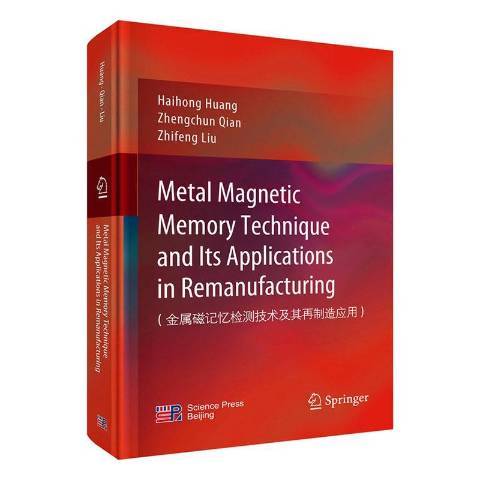內容簡介
《金屬磁記憶檢測技術及其再製造套用(英文版)》旨在將一種新型的無損檢測方法,即金屬磁記憶技術引入到再製造工程領域,為再製造產品的質量控制提供指導。《金屬磁記憶檢測技術及其再製造套用(英文版)》詳細介紹了金屬磁記憶的研究現狀及其在再製造中的套用前景,闡述了如何利用磁記憶信號檢測再製造之前毛坯的損傷程度,分析了不同載荷形式和環境變化對檢測結果的影響;並且對再製造之後零部件修復質量開展了系統評價,建立了磁記憶信號特徵與再製造塗層及其界面性能之間的映射關係;後根據金屬磁記憶基本原理開發了一套高精度的磁信號檢測設備,並將《金屬磁記憶檢測技術及其再製造套用(英文版)》總結提出的磁記憶理論模型、分析方法以及檢測結果推廣到汽車驅動橋殼、液壓缸、發動機曲軸等零部件的實際再製造過程中,為金屬磁記憶在再製造工程中的套用奠定堅實基礎。
圖書目錄
Contents
Applications for Remanufacturing Problems and Prospects
Part I Introduction to the Metal Magnetic Memory (MMM) Technique
1 Nondestructive Testing for Remanufacturing 3
1.1 Motivations 3
1.2 Conventional Nondestructive Testing Techniques 5
1.3 MMM Technique 5
1.4 Organization of This Book 7
References 8
2 Theoretical Foundation of the MMM Technique 9
2.1 Background 10
2.2 Microscopic Mechanism 13
2.3 Macroscopic Theoretical Model 13
2.3.1 Magnetomechanical Model 17
2.3.2 Magnetic Charge Model 19
2.3.3 First Principle Theory 23
References 23
3 State of the Art of the MMM Technique 25
3.1 Historical Background 25
3.2 Theoretical Research 26
3.3 Experimental Research 27
3.4 Standard Establishment 30
3.5 Applications for Remanufacturing 31
3.6 Problems and Prospects 32
References 34
Part II Detection of Damage in Ferromagnetic Remanufacturing Cores by the MMM Technique 39
4 Stress Induces MMM Signals 39
4.1 Intxoductioii 39
4.2 Variations in the MMM Signals Induced by Static Stress 40
4.2.1 Under the Elastic Stage 41
4.2.2 Under the Plastic Stage 42
4.2.3 Theoretical Analysis 44
4.3 Variations in the MMM Signals Induced by Cyclic Stress 45
4.3.1 Under Different Stress Cycle Numbers 46
4.3.2 Characterization of Fatigue Crack Propagation 49
4.4 Conclusions 52
References 52
5 Frictional Wear Induces MMM Signals 55
5.1 Introduction 55
5.2 Reciprocating Sliding Friction Damage 56
5.2.1 Variations in the Tribology Parameters During Friction 58
5.2.2 Variations in the Magnetic Memory Signals Parallel to Sliding 60
5.2.3 Variations in the Magnetic Memory Signals Normal to Sliding 62
5.2.4 Relationship Between the Tribology 65
Characteristics and Magnetic Signals 66
5.3 Single Disassembly Friction Damage 68
5.3.1 Surface Damage and Microstructure Analysis 69
5.3.2 Variations in the MMM Signals 73
5.3.3 Damage Evaluation of Disassembly 76
5.3.4 Verification for Feasibility and Repeatability 80
5.4 Conclusions 81
References 81
6 Stress Concentration Impacts on MMM Signals 83
6.1 Introduction 84
6.2 Stress Concentration Evaluation Based on the Magnetic Dipole Model 84
6.2.1 Establishment of the Magnetic Dipole Model 86
6.2.2 Characterization of the Stress Concentration Degree 86
6.2.3 Contributions of Stress and Discontinuity to MMM Signals 91
6.3 Stress Concentration Evaluation Based on the Magnetic Dual-Dipole Model 95
6.3.1 Magnetic Scalar Potential 95
6.3.2 Magnetic Dipole and Its Scalar Potential 97
6.3.3 Measurement Process and Results 100
6.3.4 Analysis of the Magnetic Scalar Potential 103
6.4 Stress Concentration Inversion Method 110
6.4.1 Inversion Model of the Stress Concentration Based on the Magnetic Source Distribution 110
6.4.2 Inversion of a One-Dimensional Stress Concentration 112
6.4.3 Inversion of a Two-Dimensional Stress Concentration 114
6.5 Conclusions 114
References 115
7 Temperature Impacts on MMM Signals 117
7.1 Introduction 117
7.2 Modified J-A Model Based on Thermal and Mechanical Effects 117
7.2.1 Effect of Static Tensile Stress on the Magnetic Field 118
7.2.2 Effect of Temperature on the Magnetic Field 119
7.2.3 Variation in the Magnetic Field Intensity 120
7.3 Measurement of MMM Signals Under Different Temperatures 121
7.3.1 Material Preparation 122
7.3.2 Testing Method 122
7.4 Variations in MMM Signals with Temperature and Stress 123
7.4.1 Normal Component of the Magnetic Signal 125
7.4.2 Mean Value of the Normal Component of the Magnetic Signal 128
7.4.3 Variation Mechanism of the Magnetic Signals Under Different Temperatures 130
7.4.4 Analysis Based on the Proposed Theoretical Model 131
7.5 Conclusions 132
References 132
8 Applied Magnetic Field Strengthens MMM Signals 133
8.1 Introduction 133
8.2 MMM Signal Strengthening Effect Under Fatigue Stress 134
8.2.1 Variations in the MMM Signals with an Applied Magnetic Field 135
8.2.2 Theoretical Explanation Based on the Magnetic Dipole Model 137
8.3 MMM Signal Strengthening Effect Under Static Stress 139
8.3.1 Magnetic Signals Excited by the Geomagnetic Field 140
8.3.2 Magnetic Signals Excited by the Applied Magnetic Field 142
8.4 Conclusions 146
References 147
Part III Evaluation of the Repair Quality of Remanufacturmg Samples by the MMM Technique
9 Characterization of Heat Residual Stress During Repair 151
9.1 Introduction 151
9.2 Preparation of Cladding Coating and Measurement of MMM Signals 153
9.2.1 Specimen Preparation 153
9.2.2 Measurement Method 153
9.2.3 Data Preprocessing 155
9.3 Distribution of MMM Signals near the Heat Affected Zone 156
9.3.1 Magnetic Signals Parallel to the Cladding Coating 156
9.3.2 Magnetic Signals Perpendicular to the Cladding Coating 157
9.3.3 Three-Dimensional Spatial Magnetic Signals 159

